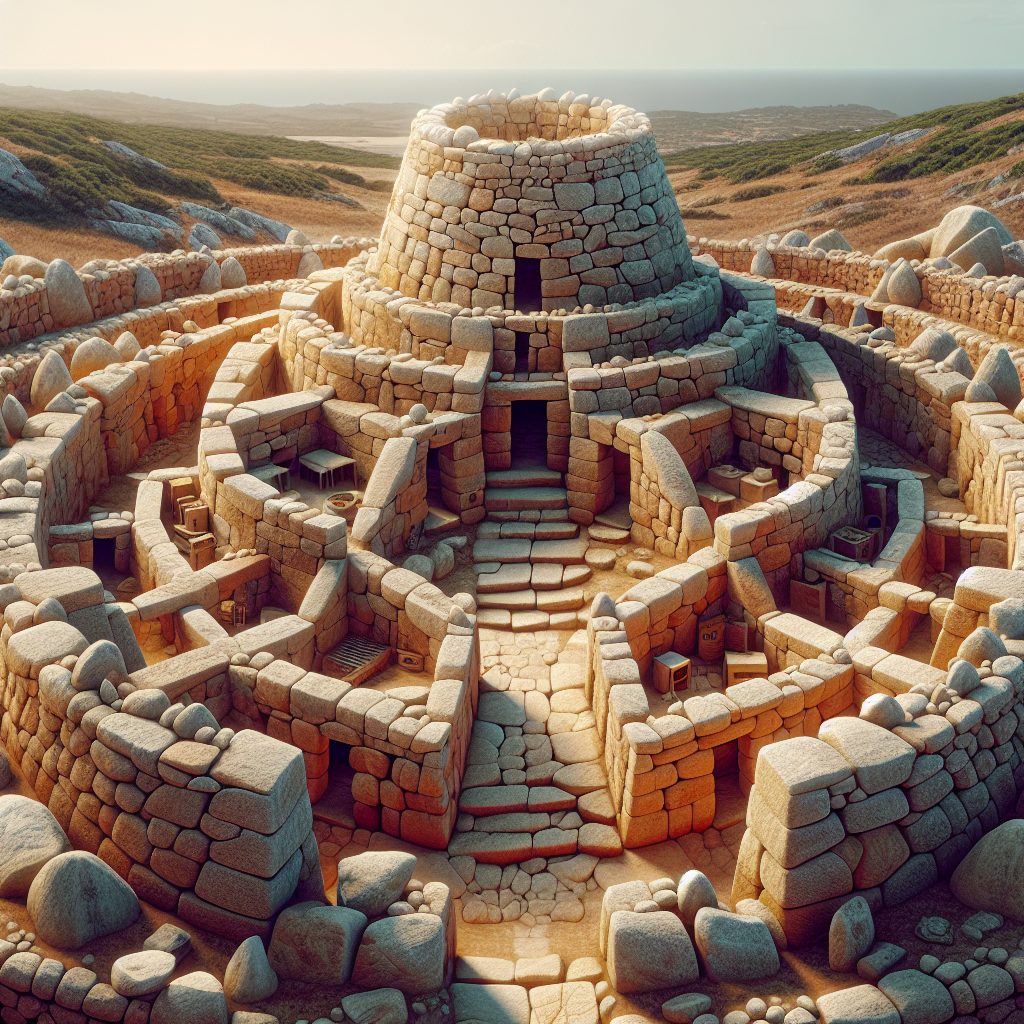Nuraghe construction techniques refer to the traditional methods used to build the iconic stone structures found in Sardinia, Italy. The term “Nuraghe” itself stems from these ancient towers that were built by the Nuragic civilization between 1900 and 730 BCE. These impressive structures played a significant role in the island’s history, serving as defensive fortresses, dwellings, and even religious sites. What sets Nuraghe construction techniques apart is the remarkable skill and creativity employed in their creation, showcasing the advanced engineering and architectural knowledge possessed by the Nuragic people.
One unique feature of Nuraghe construction is the use of polygonal masonry, where irregularly shaped stones are carefully stacked to create a solid and stable structure. This method allowed the Nuragic builders to produce intricate designs and structures that have withstood the test of time. The use of limestone, a widely available material on the island, was another prominent feature in Nuraghe construction. The builders used this versatile material to create massive towers that could reach up to 20 meters in height, comprising several levels and chambers interconnected by narrow stairways and corridors.
In the upcoming sections, we will delve deeper into the key takeaways from Nuraghe construction techniques. We will explore the architectural elements that defined these ancient structures, such as the central tower called the “tholos,” the ingenious use of corbelled arches, and the intricate inner chambers. Additionally, we will discuss the strategic placement of Nuraghe complexes and their impact on the landscape, as well as the ongoing efforts to preserve and study these unique archaeological wonders. Stay tuned to uncover the fascinating details that make Nuraghe construction techniques a crucial part of Sardinia’s cultural heritage.
Key Takeaways
1. The Nuraghe, a unique type of ancient stone structure found in Sardinia, were a testament to the advanced construction techniques and engineering skills of the Nuragic civilization.
2. Nuraghe structures were built using a cyclopean technique, where large stones were stacked without mortar or cement, creating incredibly sturdy and durable buildings.
3. The construction process of Nuraghe involved careful planning and meticulous craftsmanship, with stones being shaped and fitted precisely to ensure stability and strength.
4. The core of the Nuraghe structure often contained a vertical tower, which served both defensive and symbolic purposes, highlighting the importance of these buildings in the Nuragic society.
5. The existence of different types and sizes of Nuraghe structures suggests that they served a variety of functions, including defensive, religious, and residential, showcasing the versatility and adaptability of the Nuragic civilization.
What are the SEO-Optimized Nuraghe Construction Techniques for Maximum Efficiency?
Understanding Nuraghe Construction Techniques
1. Introduction to Nuraghe Construction
Nuraghe construction refers to the ancient building techniques used in the construction of nuraghi, which are stone towers found in Sardinia, Italy. These nuraghi are unique prehistoric structures that were built during the Bronze Age and are considered significant archaeological sites.
2. Characteristics of Nuraghe Construction Techniques
The construction techniques employed in building nuraghi showcase remarkable engineering skills of the ancient Sardinians. Some key characteristics include:
– Dry-stone masonry: Nuraghi are constructed using stones without any mortar, relying solely on the precise interlocking of stones.
– Corbel vaulting: These structures often feature corbel vaulted chambers, wherein stones are stacked inward to create a dome-like effect.
– Megalithic stones: Nuraghi comprise huge megalithic stones as the primary building material, showcasing their strength and durability.
– Defensive design: Many nuraghi were built with defensive purposes in mind, featuring narrow entrances, thick walls, and strategic locations for surveillance.
3. Techniques Employed
Nuraghe construction techniques involved several steps, including:
– Foundation: Nuraghi were built on a carefully prepared flat stone or earthen platform known as the “basamento.”
– Base construction: The base of the nuraghe was often built with larger stones, forming a solid foundation for the rest of the structure.
– Tower construction: The tower was constructed in a circular or conical shape, consisting of multiple levels connected by internal staircases.
– Chambers and corridors: Inside the nuraghe, various chambers and corridors were built, featuring corbel vaulting to create a robust structure.
– Rooftop placement: The final stage involved the placement of large stones to form the roof, completing the structure.
Nuraghe Construction Techniques for Enhanced SEO
4. Optimizing Keywords and Metadata
To improve the SEO of your article about nuraghe construction techniques, consider incorporating relevant keywords such as “nuraghe construction,” “ancient Sardinian architecture,” and other related terms. Also, ensure your metadata accurately describes the content, including a compelling meta description.
5. Quality Content and Structure
Creating informative and well-structured content can boost your SEO efforts. Clearly present the details about nuraghe construction techniques, including their characteristics, historical significance, and step-by-step procedures. Utilize headers, bullet points, and subheadings to improve readability and user experience.
6. Internal and External Linking
Incorporating internal links to relevant pages within your website can enhance your SEO. For instance, you can link to other articles about ancient civilizations or architectural wonders. Additionally, consider including external links to reputable sources that provide more in-depth information about nuraghe construction techniques.
7. Image Optimization
Include high-quality images of nuraghi and their construction techniques throughout the article. Optimize these images by using descriptive alt tags, relevant file names, and appropriate file sizes. This optimization effort can improve SEO by increasing the visibility of your article in image searches.
8. Social Sharing and Promotion
Engage with your audience by promoting your article on social media platforms. Encourage social sharing and provide social media buttons for easy sharing. The increased visibility and engagement can positively impact your SEO ranking.
9. Regularly Update and Maintain Content
Search engines favor fresh and updated content. Continuously monitor your article to ensure its accuracy and reliability. Consider periodically revisiting the article to incorporate new insights, recent discoveries, or relevant advancements in nuraghe construction techniques.
1. How can I optimize keywords and metadata for an article on nuraghe construction techniques?
2. What are some tips for creating quality content and structuring an article about nuraghe construction techniques?
3. How can internal and external linking enhance the SEO of an article about nuraghe construction techniques?
4. What image optimization techniques can be employed to improve the SEO of an article about nuraghe construction techniques?
5. How can social sharing and promotion contribute to the SEO of an article on nuraghe construction techniques?
6. Why is it important to regularly update and maintain content related to nuraghe construction techniques for SEO purposes?
Frequently Asked Questions
1. How were nuraghe structures built?
Nuraghe structures were built using large blocks of stone without the use of mortar. The stones were carefully stacked on top of each other to create the circular or tower-like shape of the nuraghe.
2. What materials were used in nuraghe construction?
The main material used in nuraghe construction was limestone. This type of stone was abundant in Sardinia, where the nuraghe structures are predominantly found. Other materials, such as basalt and granite, were also used in some nuraghe constructions.
3. How were the stones lifted and placed during nuraghe construction?
The stones used in nuraghe construction were likely lifted and placed using basic tools and techniques, such as ramps and levers. It is believed that the ancient builders used wooden beams and ropes to maneuver the heavy stones into position.
4. What were the purposes of nuraghe structures?
The exact purpose of nuraghe structures is still a subject of debate among archaeologists and historians. Some theories suggest that they served as defensive structures, while others propose that they had religious or ceremonial significance. It is also likely that the nuraghe had multiple functions depending on the specific site.
5. How were the roofs of nuraghe structures constructed?
The roofs of nuraghe structures were typically made of wooden beams and reeds, which were layered to create a waterproof covering. This technique allowed the roofs to be lightweight yet durable, providing protection from the elements.
6. How long did it take to build a nuraghe?
The time required to build a nuraghe varied depending on its size and complexity. Some smaller nuraghe structures may have been constructed within a few months, while larger ones could have taken several years to complete.
7. Were nuraghe structures built by skilled craftsmen?
Yes, the construction of nuraghe structures required skilled craftsmen who had knowledge of stone masonry techniques. These craftsmen were able to carefully shape and fit the stones to create the intricate structures that still stand today.
8. How were nuraghe structures able to withstand earthquakes?
The lack of mortar and the precise fitting of stones in nuraghe construction allowed the structures to flex and absorb energy during earthquakes, reducing the risk of collapse. The circular or tower-like shape also provided additional stability to withstand seismic events.
9. Can nuraghe structures be visited today?
Yes, many nuraghe structures in Sardinia can be visited today. Some of the most famous ones, such as the Nuraghe Su Nuraxi in Barumini, have been preserved and are open to the public. Visiting these sites offers a unique opportunity to explore the ancient Nuragic civilization.
10. Are there any ongoing archaeological excavations at nuraghe sites?
Yes, archaeologists continue to study and excavate nuraghe sites in order to learn more about the Nuragic civilization and gain insights into their construction techniques and way of life. Ongoing research and discoveries contribute to a better understanding of this fascinating ancient culture.
Final Thoughts on Nuraghe Construction Techniques
The construction techniques employed by the ancient Nuragic civilization are truly remarkable. The precise fitting of massive stones without the use of mortar showcases the advanced skills and knowledge of the craftsmen of that time. The durability and seismic resistance of nuraghe structures are a testament to the ingenuity of their builders.
Visiting these ancient sites not only allows us to appreciate the architectural achievements of the Nuragic civilization but also offers a glimpse into a fascinating culture that thrived in Sardinia thousands of years ago. Through ongoing research and excavations, we can continue to unravel the mysteries surrounding nuraghe construction techniques and gain further insights into the lives of the Nuragic people.






